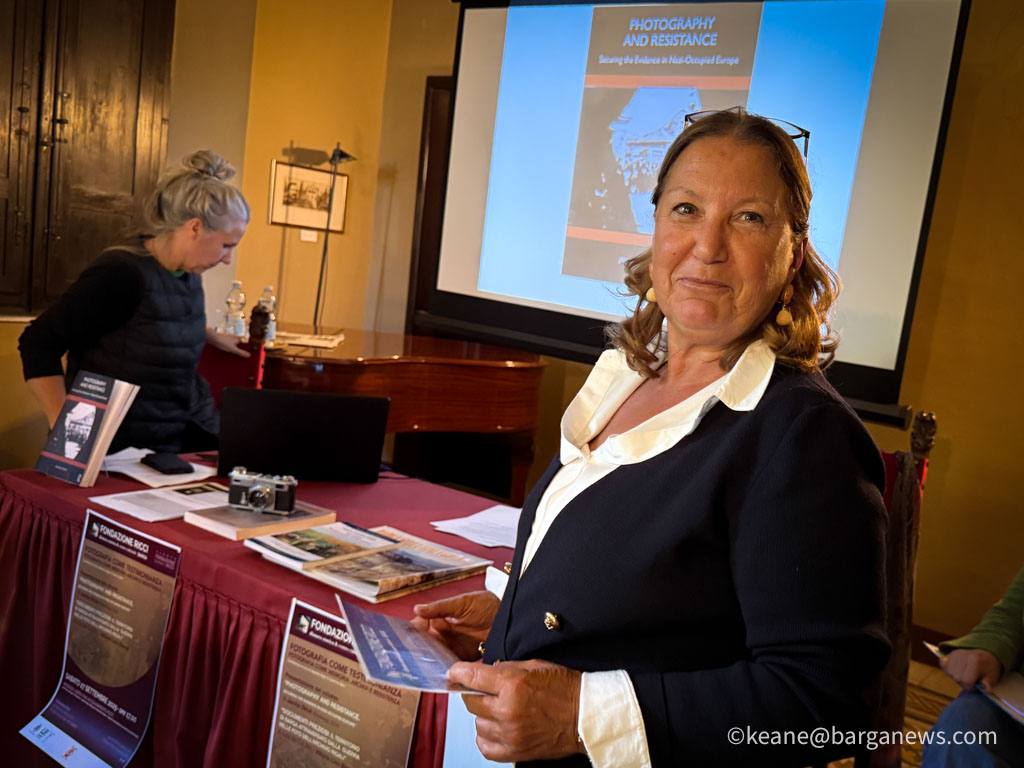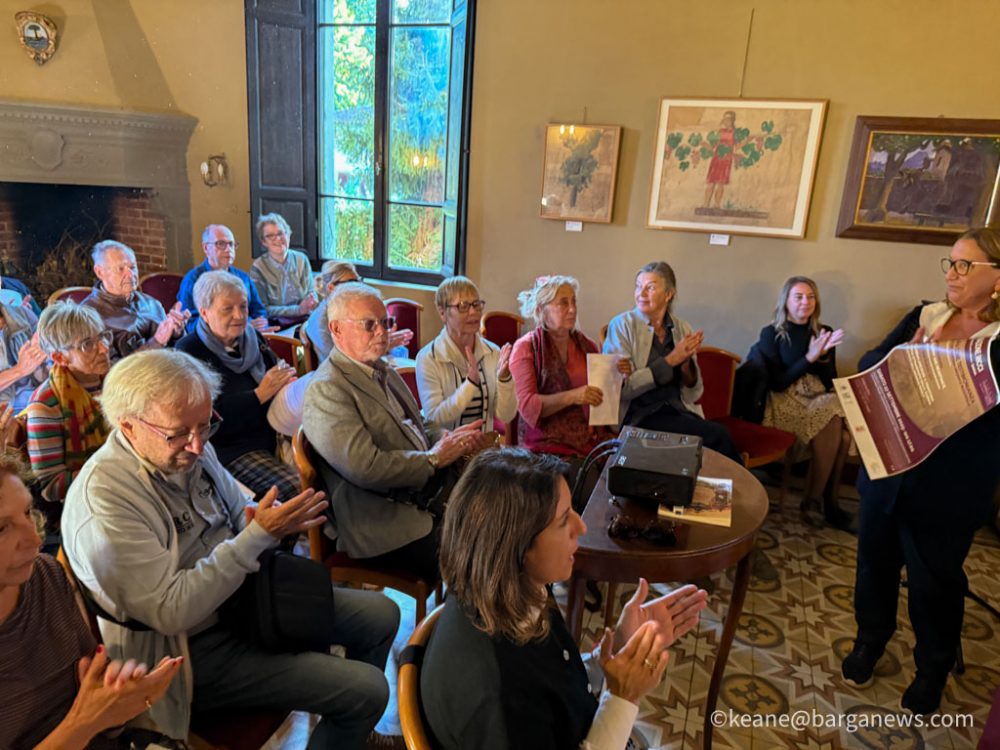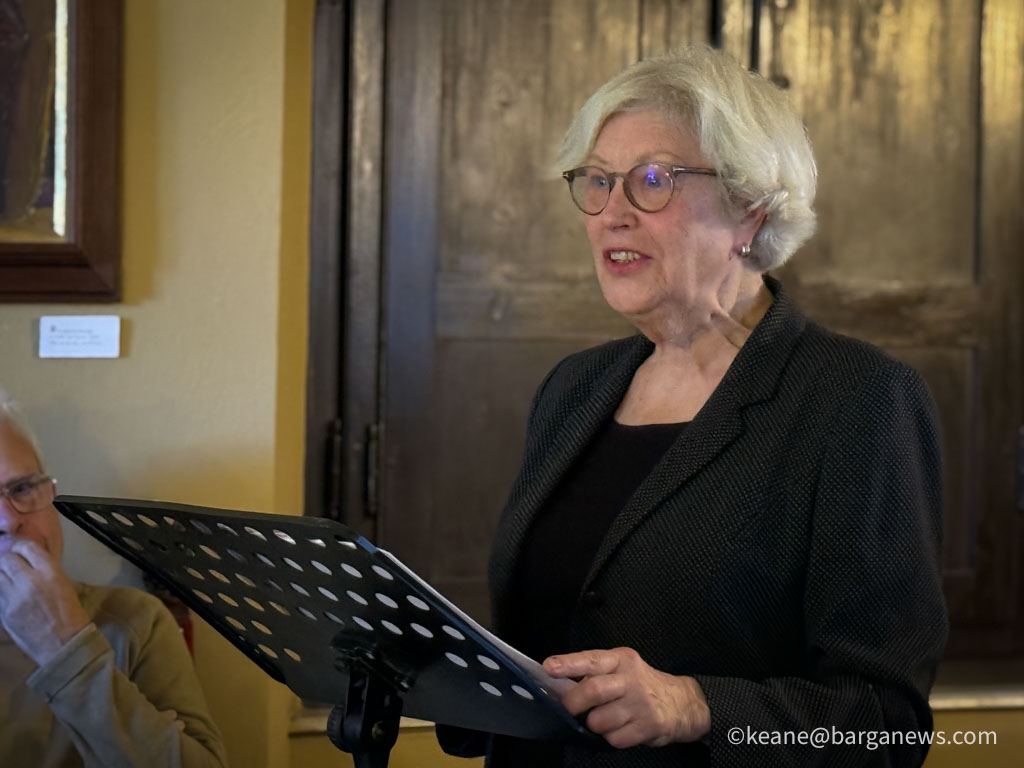The vaulted rooms of the Fondazione Ricci in Barga once again became a stage for reflection and dialogue on the afternoon of Saturday, 27 September, as scholars, photographers and citizens gathered for Photography as Testimony, Photography as Memory: Archives and Resistance.
The event, curated by Caterina Salvi, invited the public to consider the profound role of photography in shaping and safeguarding collective memory. At the heart of the discussion was a dialogue between two very different but complementary figures. On one side stood Janina Struk, the London-based freelance documentary photographer, writer and lecturer whose work has consistently examined the ethical and historical weight of the photographic image. On the other side was Col. (Res.) Vittorio Lino Biondi, decorated veteran, historian and tireless guardian of military memory in the Serchio Valley. Struk’s presentation centred on her recent book, Photography and Resistance. Securing the Evidence in Nazi-Occupied Europe (Routledge, 2024).
Drawing on years of research, she illustrated how photographs had functioned not merely as records but as active instruments of survival, testimony and, in some cases, resistance during one of Europe’s darkest periods. The audience was reminded that images could be as powerful as words in confronting violence and injustice. Biondi then opened the door to a more local history.
From the Pietro Rigali photographic archive, he presented rarely seen images taken in Barga during the Fascist Ventennio and the years when the Gothic Line cut through the city. These photographs, both stark and intimate, depicted a territory scarred by war yet resilient in the rhythm of daily life. They stood as silent witnesses — testifying to the endurance of a community under oppression. What unfolded was not simply a lecture but a true conversation: theory meeting image, academic reflection intertwined with visual memory. The afternoon underscored the responsibility of preserving archives, not as static collections of the past, but as dynamic tools for understanding and transmitting history to future generations. The event was bilingual, with translation by Isabella Negri. The atmosphere was one of attentive silence, broken only by questions that revealed both curiosity and a sense of personal connection to the stories being told.
Janina Struk has long been recognised for her incisive exploration of the relationship between photography and history. Her earlier works — Photographing the Holocaust: Interpretations of the Evidence (2004) and Private Pictures: Soldiers Inside View of War (2011) — are considered key texts in the field. Beyond her publications, she has collaborated with the Imperial War Museum in running workshops for History and Holocaust teachers and has led photo-reportages in the UK, Poland, Cuba and Kashmir.
Col. Vittorio Lino Biondi, meanwhile, brought the authority of lived experience. An officer of the Folgore Paratrooper Brigade, decorated for numerous missions both military and humanitarian, he has also dedicated much of his later life to cultural and historical research.
His book The Battle of Sommocolonia was translated into English and adopted by Charleston University, South Carolina, as part of its Contemporary History curriculum. His ongoing work places the Serchio Valley firmly within the broader European story of the 20th century.
The afternoon also reaffirmed the role of the Fondazione Ricci as one of Barga’s central cultural spaces. Founded with the mission of preserving and showcasing the city’s historical and artistic heritage, the foundation has, in recent years, become a hub for exhibitions, lectures and community debates that bring local memory into dialogue with wider international themes.
Saturday’s event fitted seamlessly into that tradition — bridging the global and the local, scholarship and testimony. In the end, what lingered in the minds of many who attended was the reminder that photographs are not passive artefacts. They are evidence, they are resistance, and they are memory itself — fragile yet enduring. In the hands of Struk and Biondi, they became a call to recognise the past, to honour it, and to ensure it is never forgotten.
Conservare la memoria: Fotografia, Archivi e Resistenza alla Fondazione Ricci Le sale voltate della Fondazione Ricci a Barga sono tornate ad essere, nel pomeriggio di sabato 27 settembre, un luogo di riflessione e dialogo, quando studiosi, fotografi e cittadini si sono riuniti per l’incontro Fotografia come testimonianza, Fotografia come memoria: Archivi e Resistenza.
L’appuntamento, curato da Caterina Salvi, ha invitato il pubblico a interrogarsi sul ruolo profondo della fotografia nella costruzione e nella salvaguardia della memoria collettiva. Al centro della discussione c’erano due figure diverse ma complementari. Da un lato Janina Struk, fotografa documentarista freelance, scrittrice e docente a Londra, che da anni indaga il peso etico e storico dell’immagine fotografica.
Dall’altro il Col. (Ris.) Vittorio Lino Biondi, veterano decorato, storico e custode instancabile della memoria militare nella Valle del Serchio. L’intervento di Struk ha ruotato intorno al suo più recente volume, Photography and Resistance. Securing the Evidence in Nazi-Occupied Europe (Routledge, 2024). Frutto di anni di ricerca, il libro ha mostrato come la fotografia non sia stata soltanto una traccia, ma anche uno strumento attivo di sopravvivenza, di testimonianza e, in certi casi, di resistenza durante uno dei periodi più bui della storia europea.
Il pubblico ha riscoperto come le immagini possano avere la stessa forza delle parole nel denunciare violenza e ingiustizia. Biondi ha poi riportato l’attenzione a una memoria più locale. Attraverso l’Archivio fotografico Pietro Rigali, ha presentato immagini raramente viste, scattate a Barga durante il Ventennio fascista e negli anni in cui la Linea Gotica attraversava la città. Fotografie al tempo stesso dure e intime, che raccontavano un territorio ferito dalla guerra ma capace di mantenere i ritmi della vita quotidiana. Documenti silenziosi, testimoni dell’endurance di una comunità sotto l’oppressione. Non si è trattato di una semplice conferenza, ma di un vero dialogo: teoria e immagine intrecciate, riflessione accademica e memoria visiva fuse insieme.
Il pomeriggio ha sottolineato la responsabilità di custodire gli archivi non come raccolte statiche del passato, ma come strumenti dinamici per comprendere e trasmettere la storia alle generazioni future. L’incontro, bilingue con traduzione di Isabella Negri. L’atmosfera era di attento silenzio, interrotto soltanto da domande che rivelavano curiosità e un forte senso di legame personale con le vicende raccontate. Janina Struk è riconosciuta a livello internazionale per la sua indagine critica sul rapporto tra fotografia e storia. I suoi volumi precedenti — Photographing the Holocaust: Interpretations of the Evidence (2004) e Private Pictures: Soldiers Inside View of War (2011) — sono testi di riferimento nel settore. Oltre alle pubblicazioni, ha collaborato con l’Imperial War Museum per workshop destinati agli insegnanti di Storia e dell’Olocausto, e ha realizzato reportage fotografici nel Regno Unito, in Polonia, a Cuba e in Kashmir.
Il Col. Vittorio Lino Biondi ha invece portato l’autorevolezza dell’esperienza vissuta. Ufficiale della Brigata Paracadutisti Folgore, decorato in numerose missioni sia militari che umanitarie, ha dedicato gran parte della sua vita successiva alla ricerca storica e culturale.
Il suo libro La battaglia di Sommocolonia è stato tradotto in inglese e adottato come testo universitario di Storia Contemporanea alla Charleston University in South Carolina. Le sue ricerche collocano la Valle del Serchio all’interno della più ampia storia europea del Novecento.
Il pomeriggio ha riaffermato anche il ruolo della Fondazione Ricci come uno degli spazi culturali centrali di Barga. Nata con la missione di conservare e valorizzare il patrimonio storico e artistico della città, negli ultimi anni la Fondazione si è affermata come polo per mostre, conferenze e dibattiti capaci di mettere in dialogo la memoria locale con temi internazionali.
L’incontro di sabato si è inserito perfettamente in questa tradizione: un ponte tra globale e locale, tra ricerca e testimonianza. Alla fine, ciò che è rimasto più impresso a molti dei presenti è stato il ricordo che la fotografia non è mai un artefatto passivo. È prova, è resistenza, è memoria stessa — fragile eppure duratura. Nelle mani di Struk e Biondi si è trasformata in un invito a riconoscere il passato, a rendergli onore e a non dimenticarlo mai.










